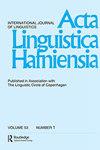Introduction: communicative dynamism
Q2 Arts and Humanities
引用次数: 1
Abstract
This issue on Communicative Dynamism brings together contributions investigating various dimensions of what is most commonly called information structure. In terms of theoretical affiliation, all contributors have their roots in the Hallidayan functional tradition, whose indebtedness to Prague School linguistics is well-established (e.g., Halliday 1974; Davidse 1987). By choosing the term Communicative Dynamism coined by Czech linguist Jan Firbas as the theme of the issue, we pay tribute to the pioneering role played by the Prague School and to the lasting modernity and relevance of their work. In this introduction, we first outline the theoretical notions and descriptive distinctions proposed by the Prague School that are relevant to this issue (Section 1). In Section 3, we discuss the various dimensions of information structure and communicative dynamism addressed in the contributions. In tackling specific theoretical and descriptive issues, the contributions incorporate elements not only from Hallidayan and Prague School functionalism but also from other traditions such as Cognitive Grammar, which we cover in Section 2. This eclectic functionalism is in accordance with VilémMathesius’ adage “Language is a fortress that must be assailed from all sides and with every kind of weapon” (Chovanec 2014, 6), which Jan Firbas loved to cite (Firbas 1992b, 167).引言:交际动力
本期《交际动力》汇集了研究最常被称为信息结构的各个维度的贡献。在理论联系方面,所有贡献者都植根于哈利达扬的功能传统,其对布拉格学派语言学的负债是公认的(例如,哈利达1974;Davidse 1987)。我们选择捷克语言学家Jan Firbas创造的“交际动力”一词作为本期的主题,是为了向布拉格学派所发挥的先锋作用以及他们工作的持久现代性和相关性致敬。在本引言中,我们首先概述了布拉格学派提出的与该问题相关的理论概念和描述性区别(第1节)。在第3节中,我们讨论了论文中涉及的信息结构和交际动态的各个维度。在处理具体的理论和描述问题时,这些贡献不仅结合了哈利达扬和布拉格学派功能主义的元素,还结合了其他传统的元素,如认知语法,我们将在第2节中介绍。这种折衷的功能主义符合vil mmathesius的格言“语言是一座堡垒,必须从各个方面和各种武器进行攻击”(Chovanec 2014, 6), Jan Firbas喜欢引用(Firbas 1992b, 167)。
本文章由计算机程序翻译,如有差异,请以英文原文为准。
求助全文
约1分钟内获得全文
求助全文
来源期刊

Acta Linguistica Hafniensia
Arts and Humanities-Language and Linguistics
CiteScore
0.90
自引率
0.00%
发文量
5
 求助内容:
求助内容: 应助结果提醒方式:
应助结果提醒方式:


